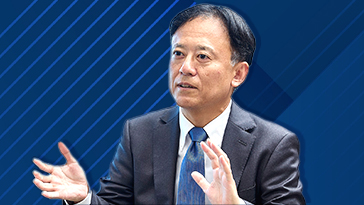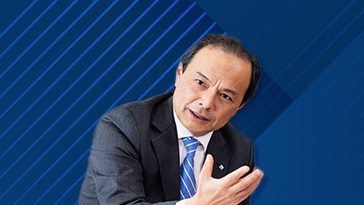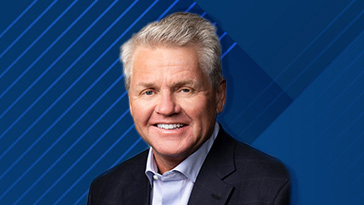ProAg is one of the oldest specialty crop insurers in the US, established in the 1920s, when its founder began selling cover to local farmers from horseback. Today, it's one of the most technologically advanced carriers in the sector and the only one to be led by a woman – Kendall Jones.
Kendall has served as ProAg's President and Chief Executive Officer since 2017 and was previously Executive Vice President and Chief Operating Officer for eight years. Here, she shares her views on some of the biggest challenges facing farmers and crop insurers in the US and how ProAg is working to overcome them.

Kendall Jones, President and Chief Executive Officer of Producers Agriculture Insurance Company (ProAg)
Weather – unsettled outlook
Drought remains the largest cause of loss for farmers in the US, and it was a significant driver behind the US Government's decision to pass legislation in the 1980s and 1990s to increase participation in the Federal Crop Insurance Program, which offers subsidized cover to growers.
ProAg is one of the carriers involved in the program and distributes cover on behalf of the federal government as well as taking its own share of risks. Kendall says the program is complex and covers 130 different commodities across around 400 million acres, with a range of different options for farmers depending on their location and crop mix.
She says: "We share risks with the federal government, but we've got to follow their rates and rules. That makes it challenging from a competitive standpoint and almost the only way we can differentiate ourselves is on service. Who we bring to the table and how they do the job is critical to our success."
"It's a very complex program and our people know the 900-page manual from back to front. That specialty expertise is absolutely critical in crop insurance and ensures farmers get the right level of cover from the program."
In addition to drought, Kendall says a spate of recent loss events has highlighted the more extreme nature of weather exposures facing farmers.
In 2020, the wildfires in California led to huge smoke taint losses at nearby vineyards. This was not something the industry had anticipated and Kendall adds: "The structure of the program and its coverage wasn't designed for the massive number of grapes that were damaged by smoke taint. But it was an insured peril, so we supported the growers and settled their claims swiftly."
Forecasting such events is exceptionally difficult, and the job isn't getting easier. "I think we've seen things become more severe, and in recent years I've seen losses that I've never experienced before in my career.
"For example, before the 2020 harvest season, there was a major derecho, which is basically a straight-line wind storm. This one travelled around 700 miles.
"Corn is very susceptible to high winds and it just devastated crops. It affected eastern Nebraska, Iowa, Illinois, Wisconsin, and Indiana. It was catastrophic for many farmers and was a significant loss for the insurance industry."
Whatever the root cause and potential solutions to the more extreme weather patterns the world is experiencing, Kendall says her priority is to ensure farmers get the support they need in the here and now and to help them make their businesses more resilient for the future.
Aligning cover to risk profile
The US crop insurance market has traditionally rated farmers on their location and crop mix. These are important factors, but they don't create an in-depth profile of individual risks. Kendall says ProAg has a model that generates a more detailed picture of farmers and how they operate.
She explains: "Seed technology has evolved significantly and some crop varieties stand up better to drought and wind. Others recover faster from hail damage. There are also fertilizers and other treatments that farmers can put down to minimize damage after a loss and promote crop recovery.
"We've developed ways to profile farmers that enable us to identify those who prioritize such approaches. They're likely to suffer smaller losses and their crops will recover faster than that of other farmers. We offer double-digit percentage discounts to these growers and want to incentivize the whole market to operate to the highest standards. It helps us, and it helps them."
Kendall says ProAg is also investing much time and energy into developing its digital capabilities and using technology to streamline the whole insurance journey.
The federal program comes with a wide range of cover options. Kendall says it's time-consuming to complete the policy application process and can be disastrous when errors occur.
She explains: "We're using remote sensing technology at the application stage to provide the data inputs and reporting requirements needed to complete policy applications. We're trying to reduce the data entry errors and the costly omissions they can lead to – if a farmer doesn't fill everything out correctly, it can invalidate their cover.
"We really want to ensure we're covering everything and that farmers can be confident their claim will be settled quickly and for the appropriate amount."
The technology will enable ProAg to give farmers a digital presentation of their risk and proposed covers. It will make it quicker and easier to check everything is in place and reduce potentially catastrophic errors and omissions in the application and renewal process.
It will also create a means to engage with farmers, show them the details of how their risk has performed in recent years, how it has been affected by weather patterns and events, and suggest possible changes to their coverage for the year ahead.
Getting this correct is essential not only for the farmer but also for the wider rural community in which they're based.
"Farms are economic hubs in their communities," says Kendall. "They provide employment and are major contributors to their local economies through their business to other firms like local grain elevators, mechanics, farm employees and seed, fertilizer and other input suppliers.
"Crop insurance supports the farmer and by keeping them in business underpins the communities in which they operate."
Operating as part of a bigger group
ProAg has a rich history as an independent business. Kendall says that none of its identity or specialty expertise has been diluted since becoming part of Tokio Marine HCC in 2014. In fact, she says the company's federated approach is something that has impressed her from day one.
She explains: "I give Tokio Marine HCC a lot of credit for its great federated governance structure. I have worked in other businesses where they don't give their experts the same autonomy and control. Tokio Marine HCC's approach allows the specialists to run day-to-day operations in the specialty sector units."
Operating within the Tokio Marine Group also brings other benefits. We've gotten access to excellent reinsurance terms at exceptional value by leveraging the scale of the Group, which makes a big difference in a competitive market."
Kendall has almost 30 years of experience in the crop insurance sector and plans to build on that in the years ahead.
She concludes: "Agriculture sits at the heart of society – without a robust agricultural sector, we don't eat. I think I've got one of the best seats in the house because I sit at the intersection of agriculture and insurance.
"Our insurance supports farmers and the broader agricultural sector when things go wrong and incentivizes them to improve and pioneer new technologies for the future.
"It's exciting, and it's essential and that drives me forward every day."







